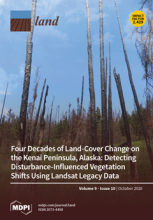Land Library
Welcome to the Land Portal Library. Explore our vast collection of open-access resources (over 74,000) including reports, journal articles, research papers, peer-reviewed publications, legal documents, videos and much more.
/ library resources
Showing items 1 through 8 of 8.Poland, like other countries in the world, increasingly experiences the ongoing climate change. However, the level of preparation of the country and its society for climate change in the second decade of the 21st century can be evaluated as low.
Given incontrovertible evidence that humans are the most powerful agents of environmental change on the planet, research has begun to acknowledge and integrate human presence and activity into updated descriptions of the world’s biomes as “anthromes”.
This report presents a case study from Senegal that explores the relationships between economic development and climate change. Urbanisation and economic diversification are transforming the climatic risks that Senegal faces and widening the rural-urban resilience gap.
The aim of this paper is to explore patterns of wastewater infrastructures (sewers vs. septic tanks) in urbanizing watersheds across a coastal metropolitan region.
Many countries in West Asia, defined in this study as the Arabic-speaking countries of the Arabian Peninsula plus Turkey and Iran, have enacted environmental conservation laws but regional underlying drivers of environment change, such as rising incomes and fast-growing populations, continue to p
Urban growth has had unprecedented consequences on environmental sustainability and anthropogenic activity. The eroding coastlines throughout the world are subject to the massive expansion of urban areas and the accountability of sustainable hinterland landscapes.
In order to address the challenges in coastal regions, there is the need to understand the extent and impacts of past changes and their implications for future management. Land use data and remotely-sensed imagery are often used to provide insights into these changes.
Indonesia, as an archipelagic nation, has about 150 million people (60%) living in coastal areas. Such communities are increasingly vulnerable to the effects of change, in the form of sea level rise and stronger, more intense storms.




